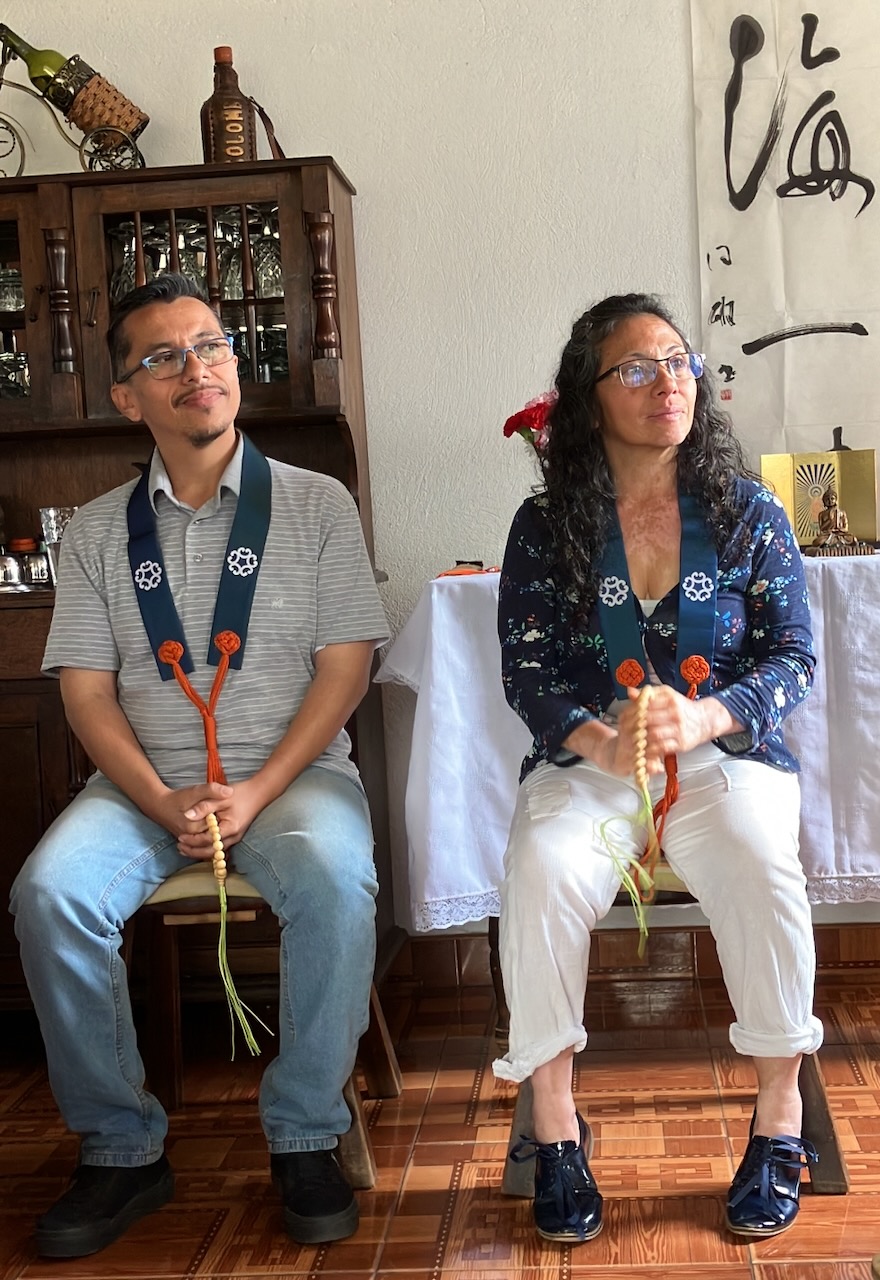
By Rev. Miki Nakura
Last month, I conducted a kikyoshiki Buddhist name ceremony in Colombia, South America. This was my third visit since 2019, when I first met Adriana Díaz Páez and her brother Juan Pablo, who were interested in Shinran Shonin’s teachings.
My friend Nori Mizukami, who lived in Colombia told me they were sincerely seeking to study Jodo Shinshu. (Nori later directed the film “Pure Land,” which documents my life of listening to the Dharma and practicing seiza “quiet sitting” meditation in New York City.
At the ceremony, Adriana said: “Ever since I was a child, I was struggling with why I had to live in this world. Sometimes I even thought about committing suicide. I was also very distressed after my divorce. But then I started to seek out Buddhism, and first encountered Zen Buddhism, then Tendai Buddhism. But I didn’t want to become a monk, so those teachings didn’t suit me. Then I finally encountered Jodo Shinshu, and its teachings are something that ordinary people can practice. My goal is to live this life with peace of mind. Naturally I chose Jodo Shinshu.”
Eight years ago, they contacted Higashi Honganji’s South America District; subsequently a group from Brazil led by Bishop Bunsho Obata visited their village outside of Boyacá. Later, I visited them and kept in touch during the COVID-19 pandemic, holding online Dharma discussions and meditation together almost every month. They expressed their desire to receive Dharma names to show their seriousness in following the Jodo Shinshu path.
Adriana and Juan Pablo were both raised in a Christian family but were unable to find answers to their struggles in life. By chance, they encountered Buddhism, which spoke to them. Colombia has an ongoing civil war and relentless violence, so they sought not only their own peace of mind, but also social peace. They felt it was somehow attainable by following the Buddhist path.
However in Jodo Shinshu, they initially were confused by many words that are also used in Christianity. For example, the word “alma” in Spanish means “spirit.” Over the past five years of study and personal experiences, they found new meaning in those words through Buddhism.
Juan Pablo said,
I think all human beings share one question. That is, wondering why we are living in this world, and I thought it was a waste to live this life as a human being. My family wanted me to become a Christian priest and I felt a lot of pressure about it, but that was not the journey I wanted to take. I always joke about it saying that if I had done so, I might have had a lot of money, women, and children. But that was not my journey. I have passed many difficult times during my lifetime. I have experienced depression and even had suicidal thoughts. What is more, before, I drank a lot of alcohol and smoked a lot of cigarettes. At the same time, I had bad relationships with people. In fact, I continued living like that and was lost. I had not yet found my path. But now, I have finally found the answer to my doubts.
First, I resolved that Christianity was no longer my religion. After that, I searched for many paths, and by chance, I encountered Buddhism. Many Buddhist ideas matched perfectly with many of my thoughts. First, it was Tibetan Buddhism. Then, eight years ago, I encountered Jodo Shinshu. I realized that dogma is not so important in Shinshu, and the most important thing is the experience of faith, so I chose Shinshu.
Over the past few years, the three of us have been practicing seiza meditation together via Zoom. Because seiza is a practice of body and breath—not reliant on verbal reasoning—it enables us to transcend language and enter directly into a “world of faith.”
For Adriana, I chose the Dharma name Shaku ni Myokou (釈尼妙光). She’s a skilled painter and her work expresses a wondrous and splendid light. I made for her a calligraphy with a passage from the Contemplation Sutra of Immeasurable Life referring to “myokou,” wonderful and splendid light.
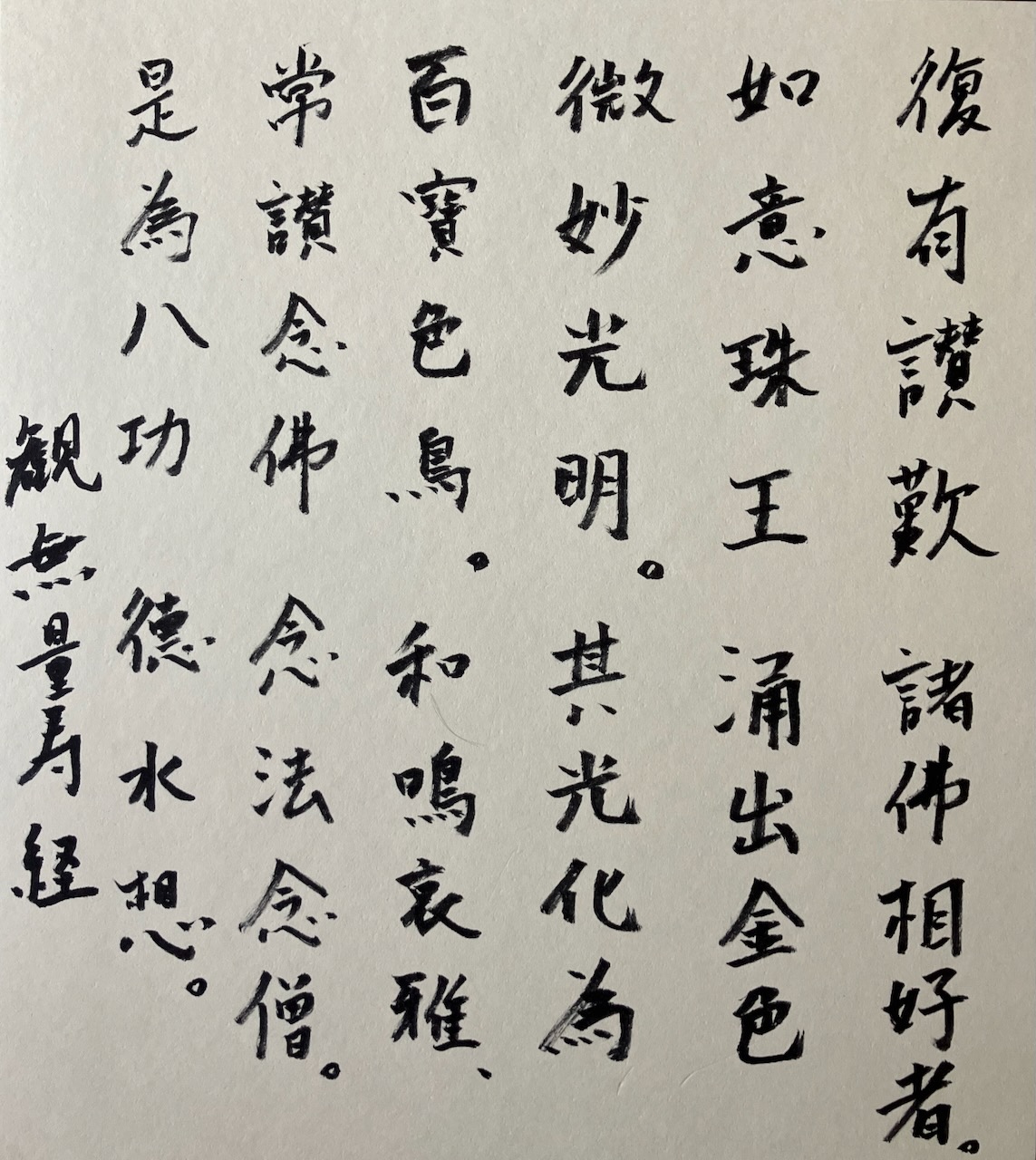
Adriana said: “Thanks to the dharma name Myokou that I received today, I now know why I’m alive. That is, I am like a polka dot in this vast ocean of light, and I shine as a polka dot. Myokou contains everything. I also love nature, and I have received the light of Amida as a small polka dot. Today is a very special day, and I am grateful for it.”
According to the Contemplation Sutra of Immeasurable Life:
Its sound also praises the physical characteristics and marks of the Buddhas. The wish-fulfilling king mani-gem emits a splendid golden light, which transforms itself into birds with the colors of a hundred jewels. Their songs are melodious and elegant, constantly praising the virtue of mindfulness of Buddha, Dharma, and Sangha. This is the visualization of the water possessing the eight excellent qualities.
(Inagaki Hisao translation)
“Myo” has a deep meaning that’s difficult to translate in English. The great Buddhist scholar D.T. Suzuki was moved by words in Shakespeare’s play, “As You Like It,” in which he saw myo, inspiring him to produce this calligraphy:
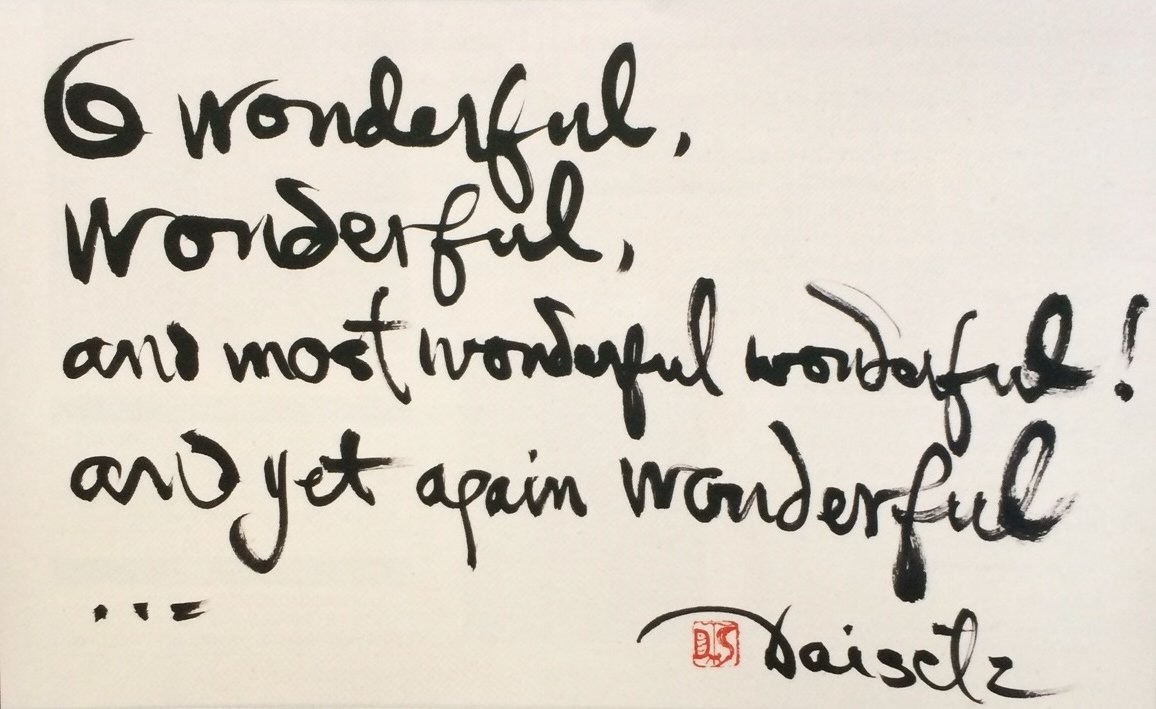
In Shoshinge, Shinran Shonin mentions this light.:
Amida Buddha radiated Light of all kinds: immeasurable, boundless, unimpeded, unparalleled, burning like the lord of flames, undefiled, joyous, full of wisdom, uninterrupted, beyond thought, indescribable, altogether surpassing the sun and the moon, shining over all the worlds as many as the particles of dust, lavishing its rays upon all beings.
Juan Pablo works as a psychologist, in which he delves deeply into the human mind. His dharma name is Anjin (安心), which means “peaceful awareness,” reflecting his goal. Anjin is similar to the word shinjin”(信心), usually translated as faith in Jodo Shinshu. Rennyo Shonin often wrote about Anjin in his letters (Japanese: Ofumi). For Juan Pablo, I wrote down a passage from one of Rennyo’s letters.
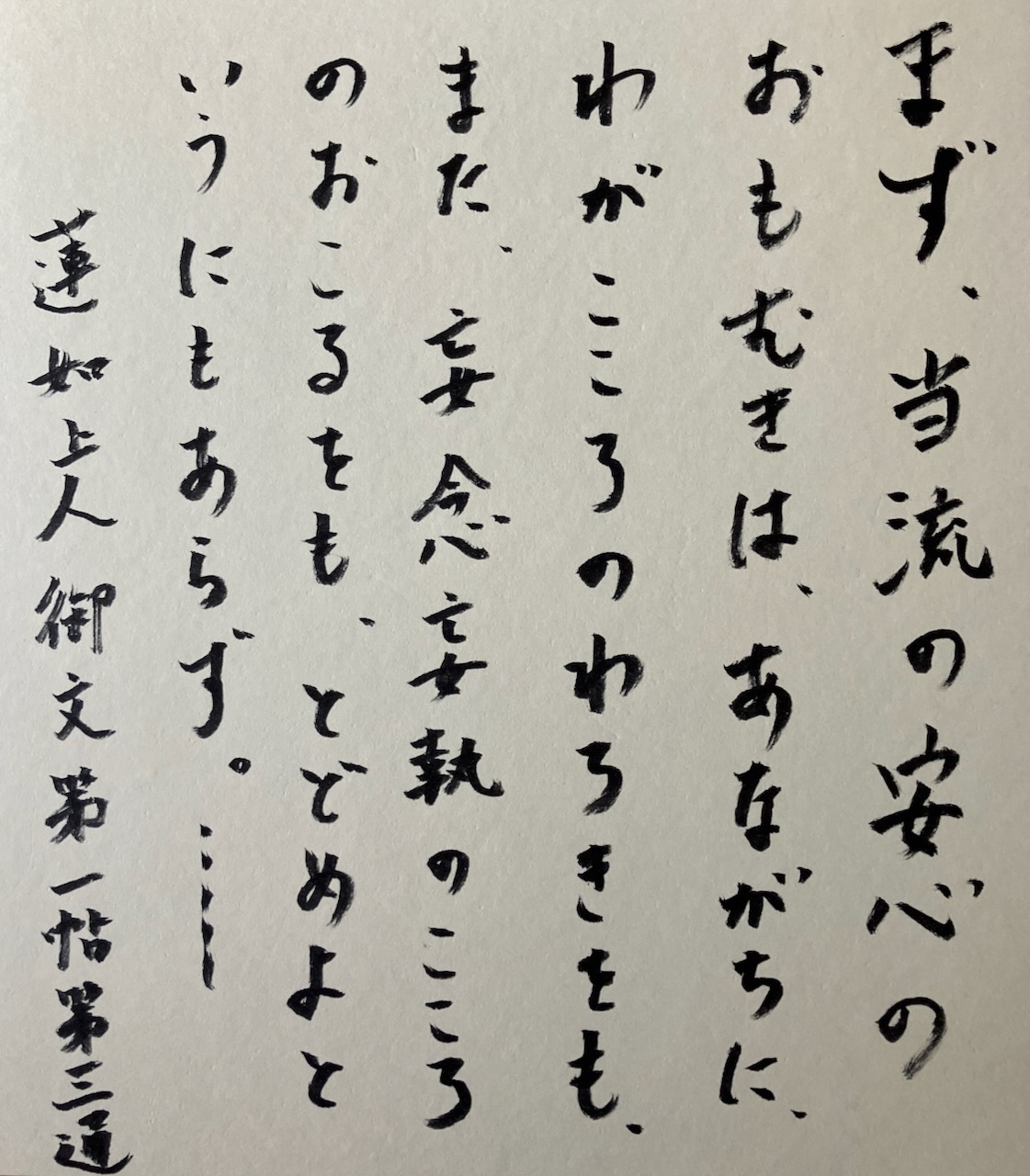
Juan Pablo said: “Experience is important to me, and the dharma name Anjin that I received today suits me well. Because my purpose in life is to have peaceful awareness, that is, anjin. I am very happy and grateful to have received this Dharma name.”
Rennyo wrote:
First of all what we call “peaceful awareness (anjin)” in our tradition does not require us to push out the bad thoughts, delusions and attachments that arise in our minds. We can simply make our living, whether in trade or domestic service, in hunting or fishing. For if we deeply believe in Amida Tathāgata’s Original Vow that vows to save such useless beings as ourselves, deludedly engaged as we are, morning and evening, in these wretched jobs of bad karma, and furthermore, if we also single-mindedly entrust ourselves to the compassionate Vow of the one Buddha, Amida, and finally sincere true faith is awakened in the one thought-moment we entrust Amida Buddha to save us, then without fail we will find ourselves embraced in the Tathāgata’s salvation. Furthermore, if you ask me with what understanding we should say the Nenbutsu, my answer is that we should say it with deep gratitude for as long as we live, grounded on the realization that through the recitation of the Nenbutsu, we thank Amida Buddha for all that he has kindly done for us, in order to give us the power of faith right here and now that has assured us of birth in the Pure Land. Those who realize this are to be called followers of faith who have decisively attained the peaceful awareness (anjin) of our tradition.
Most humbly and respectfully. On the 18th of December, Bunmei 3 (1471).
(from “Living with Thanks – The Gojo Ofumi– The Five Fascicle Version of Rennyo Shonin’s Letters,” by Kemmyo Taira Sato)
At the university where Juan Pablo works, he held a seiza session. Here’s a video of the session. Seiza is a concrete practice of realizing “peaceful awareness”.
Adriana once spoke about the question of “Other-power.” Her spiritual eyes opened when she read an analogy of a cat and a monkey in a Spanish translation of D.T. Suzuki’s book, “Buddha of Infinite Light” (El Buda de la Luz Infinita).
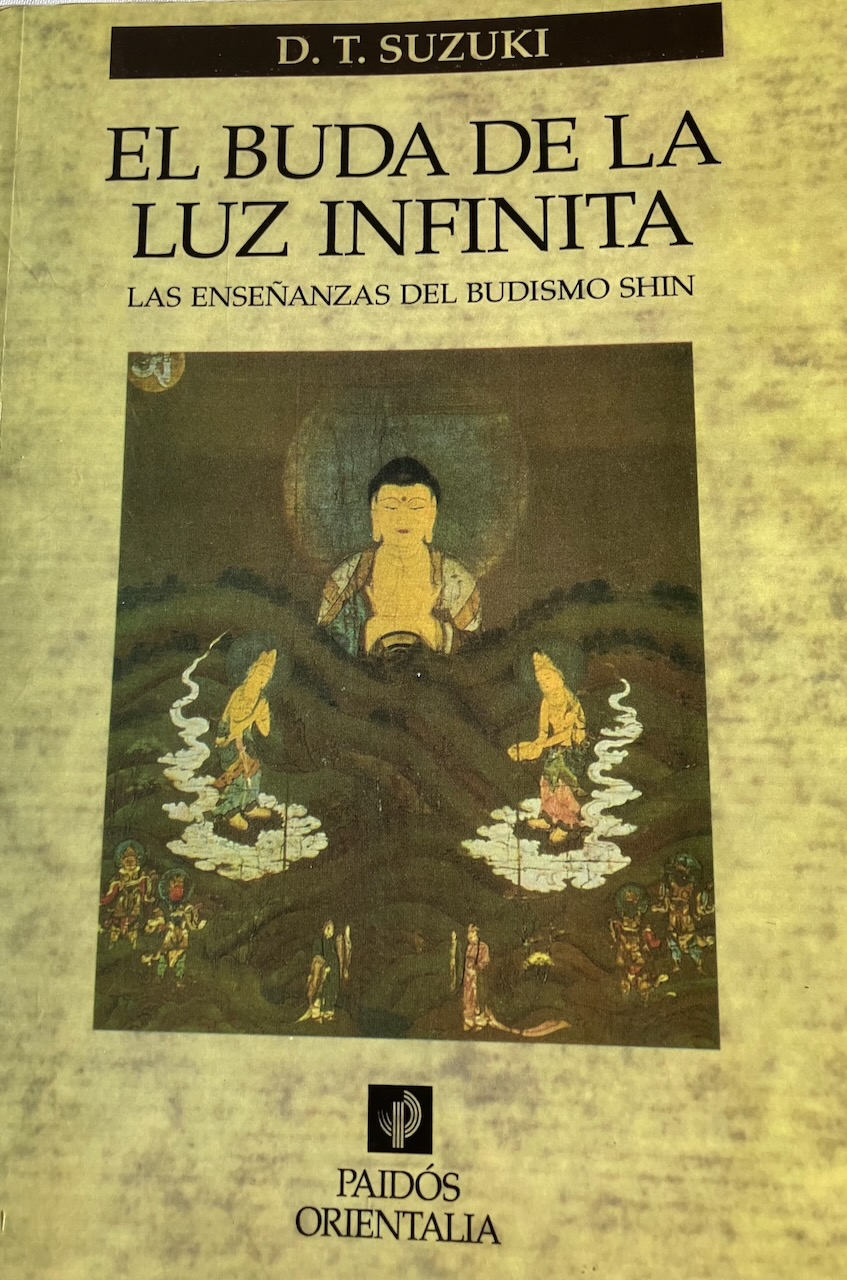
Suzuki wrote:
Let us now turn to our discussion of Other-power. Other-power is tariki in Japanese, and self-power is jiriki. The Pure Land school is known as the Other-power school because it teaches that tariki is most important in attaining birth in the Pure Land, whether understood as regeneration or enlightenment or salvation. Whatever name we may give to the end of our religious efforts, that end comes from Other-power, not from self-power. This is the contention of Shin Buddhism.
Other-power is opposed to what is known in Christian theology as synergism. This means that in the work of salvation, a person must do his or her share just as much as God does his. In contrast to synergism, the Shin school may be characterized as monergism, which means working alone in the sense that Other-power works alone, without any self-power being involved. Salvation is all Amida’s work. The relative existence which we ordinary people lead has nothing to do with effecting our birth in the Pure Land. Birth in the Pure Land is none other than attaining supreme enlightenment.
What I term monergism, the singular working of Other-power, may be illustrated by the behavior of cats. When the mother cat carries her kittens, she grasps the neck of each kitten with her mouth and carries it from one place to another. That is monergism because the kitten just let their mother carry them. In contrast, monkeys carry their offspring on their backs. This means that the baby monkeys grasp their mother’s body with their limbs or tails, so the mother is not doing all the work by herself. The baby monkeys do their share. This is the way of synergism, in contrast to the way of monergism illustrated by the behavior of cats.
In Shin teaching, we can say that it is only by the power of Amida that our liberation and freedom are assured. We don’t add anything to Amida’s working. This doctrine of Other-power, or monergism, is based on the idea that humans are relative beings, and so long as we are so constituted there is nothing in us which enables us to cross the stream of birth and death. Amida comes from the Other Shore, carries us on the ship of the Primal Vow, and delivers us on to the Other Shore.
(from Buddha of Infinite Light by D.T. Suzuki )
Finally, I found inspiring a painting of Adriana’s called, “Correspondencia.” In her work, I see myokou. I think of Suzuki’s calligraphy and the words in the Avatamsaka Sutra, which also are printed on a T-shirt of mine.
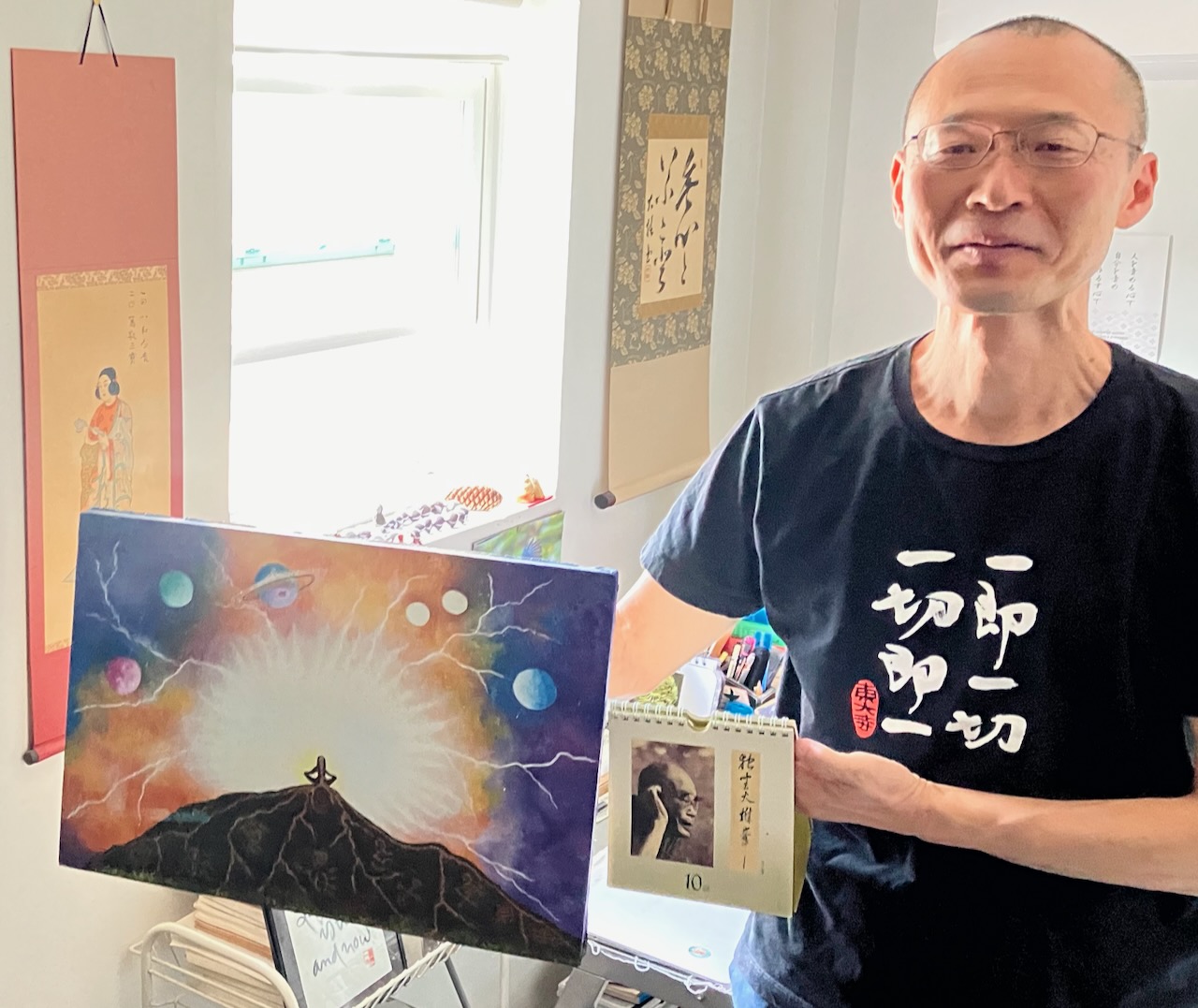
After returning to New York, I wrote to Adriana:
My T-shirt, Issoku-issai Issai-soku itsu’ (一即一切 一切即一), which means “One is all, all is one.” This phrase represents the theme of the Avatamsaka Sutra. It means seeing everything in a single object. The universe exists even in a drop of my blood. Everything corresponds to each other and supports each other. Your painting “Correspondencia” reminds me of Issoku-issai Issai-soku itsu because a person sitting in meditation corresponds to the earth and the whole universe.
D. T. Suzuki’s calligraphy Dokuza daiyuho (独坐大雄峯) means “Sitting alone on the peak of a great mountain.” A person sitting in meditation basks in the infinite light and life of Amida Buddha. These are my thoughts as I sit in my room and look at Correspondencia.
-Rev. Nakura is minister of Jodo-Shinshu Shin Buddhist New York Sangha

